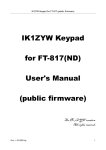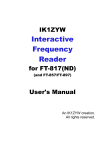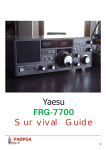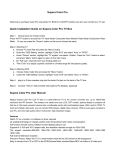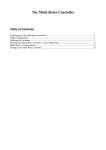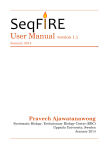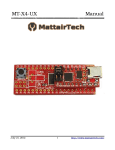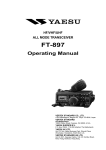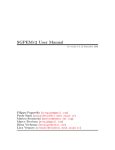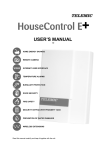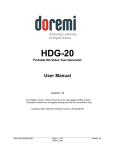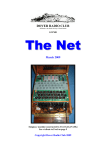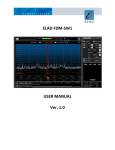Download IK1ZYW KEYPAD for FT-817(ND) User`s Manual
Transcript
IK1ZYW Keypad for FT-817 IK1ZYW KEYPAD for FT-817(ND) User's Manual An IK1ZYW creation. All rights reserved. Doc. v.20090418 1 IK1ZYW Keypad for FT-817 Table of Contents What is it?.............................................................................................................................................3 Special thanks.......................................................................................................................................4 Disclaimer.............................................................................................................................................5 Quick start............................................................................................................................................6 Tested on...............................................................................................................................................7 How it works........................................................................................................................................8 Radio setup......................................................................................................................................8 Main Menu.......................................................................................................................................8 Main functions....................................................................................................................................10 Direct frequency dial.....................................................................................................................10 Frequency presets..........................................................................................................................10 Onboard memories.........................................................................................................................10 Mode change..................................................................................................................................11 VFO toggle....................................................................................................................................12 Split toggle.....................................................................................................................................12 Lock on/off....................................................................................................................................12 Quick tune......................................................................................................................................12 Manual tune...................................................................................................................................12 Timed tuning..................................................................................................................................13 Lazy PTT.......................................................................................................................................13 RIT on/off......................................................................................................................................13 Repeater offset direction................................................................................................................14 Extra FT-817(ND) functions..............................................................................................................15 VOX toggle....................................................................................................................................15 Meter functions..............................................................................................................................15 Power level....................................................................................................................................15 Break-in toggle..............................................................................................................................16 Scan up/down/stop.........................................................................................................................16 Menu Quick Jump..........................................................................................................................16 AGC modes....................................................................................................................................17 PBT on/off.....................................................................................................................................17 Customizing........................................................................................................................................18 Support...............................................................................................................................................20 Technical specifications......................................................................................................................21 What you would get if........................................................................................................................22 Troubleshooting..................................................................................................................................23 Microcontroller programming............................................................................................................24 Assembling.........................................................................................................................................25 Connections........................................................................................................................................27 To Keypad......................................................................................................................................27 To FT-817.......................................................................................................................................28 Cheat sheet..........................................................................................................................................29 Doc. v.20090418 2 IK1ZYW Keypad for FT-817 What is it? The IK1ZYW Keypad for FT-817 is a wired partial remote control for the little Yaesu transceiver. It was conceived during a 6-hour field session at 2700 m.a.s.l. for a VHF contest in August 2008. Three functions were accessed very often, always hunting for them through the menu: power level, meter mode and VOX toggle. Some easily accessible presets would have helped quick QSYs to special band spots too. A search on Internet returned few keypads for the little 817, but none that would “export” my three most needed functions. So this project was born. First a microcontroller had to be selected. Atmel line was chosen because their chips can be programmed with high level languages (C and even BASIC!) and are cheap. Then I built the simple development hardware and started to get acquantained with the μC architecture (last I programmed was Zilog's Z80): LED blink, send VFO toggle, send frequency information, interact with the radio. It took 3 months of after-dinner development to produce the first version of a fully functional FT-817 accessory. But work is still going on... Until proven wrong, this keypad works on all series of FT-817 and FT-817ND. What is it NOT? This keypad is not a replacement of any computer-based control software. This keypad is not designed to work with all Yaesu radioes, altought basic functions should be portable to FT-857's and FT-897's: direct dial, VFO toggle, on-board presets and mode change. This keypad is not designed for use in any environment or use case that involves direct or indirect emergency traffic handling and/or life support activities. Doc. v.20090418 3 IK1ZYW Keypad for FT-817 Special thanks This project has been made possible thanks to, in chronological order: ● my Parents that bought me an experimenter's book when I was 10 and supported me in my studies, hobbies and choices ● my high school electronics Teachers Bruno De Stefano and Elisabetta Cuniberti, whose passion for the subject has furthermore marked my life ● KA7OEI that published an extensive guide to Yaesu's CAT protocol ● my supporting Wife and curious Daughter that let me dedicate some night time to this idea, and patiently tolerated the kitchen table invasion ● the growing user base that showed interest and built this keypad Doc. v.20090418 4 IK1ZYW Keypad for FT-817 Disclaimer Important notice, read twice. Although the keypad firmware is not sending dangerous data to the radio, the communication protocol does not use any form of checksum. Therefore a mis-interpretation by the radio can cause unexpected results, from a CPU crash (needing a power off-on cycle) to a complete wipe of all EEPROM data, including configuration, software calibration/alignment1 and memories. You are strongly encouraged to record at least all 76 “soft calibration” settings, plus any other information stored in your radio before using this keypad2. The 13.8Vcc line on the ACC port of FT-817 is connected to the power supply through a 10 ohm 1/16W resistor. It is not fused. Damage to the radio will occur if this line gets shorted. Moreover the voltage on ACC port is always present, including when internal batteries are installed and the radio powered off: don't forget to switch off your keypad, or unplug it when not in use! If you feel uncomfortable in using this line please use a separate 9V battery to power the keypad. Otherwise use heatshrink pipes for each pin on homemade plugs. FT-817 stores every setting in a EEPROM. EEPROM cells have a finite number of write cycles3, in the order of 10'000 or more. While front panel buttons probably wear out before EEPROM cells exhaust, using an external control interface such as this keypad (as well as any other computer software!) will increase the stress on radio internals. No responsibility is taken for data loss or any damage to your equipment. All trademarks belong to respective owners (Yaesu, Atmel, Icom, Microchip,...). 1 Software calibration settings are unique to every single device. If their values get lost you need to send your radio back to Yaesu for re-alignment. These settings are accessed by pressing keys A+B+C simultaneously and then powering up the radio. Copy them all to paper and store it in a safe place. Feel free to make several copies of your backup. 2 This safery procedure should be undertaken even when using a CAT computer cable and a computer control software. The danger is not in the keypad but in the potential misinterpretation of data by the FT817. 3 A “write cycle” includes a modification of a bit/byte. Reading settings does not count towards the write limit given by the technology chosen by Yaesu designers. Doc. v.20090418 5 IK1ZYW Keypad for FT-817 Quick start While it is worth reading this document to the end, I understand you might want to start using your keypad as soon as possible. Follow the following steps in order to get started. Steps 1 to 4 can be done before your keypad is built or in your possession. 1. Do NOT connect the keypad to the radio, YET 2. Turn on your FT-817, long press the [F] button, navigate to “14 CAT RATE” using the [SEL] rotary switch and set it to 4800 baud. Long press [F] again to store this setting. 3. Turn off the transceiver 4. (Optional but strongly recommended) Record the soft calibration settings that are exclusive for your piece of equipment. Keep [A] [B] and [C] buttons pressed while turning on the FT-817. Browse through all setting using [SEL] rotary switch and record on paper their value. Make copies of the paper and put them in the safe. Turn off the FT-817 as usual. 5. Remove ALL power sources including the internal battery, if your keypad does not carry an on/off switch 6. Connect the keypad to the rear ACC socket. Be gentle and patient, do not force it 7. Looking at the keypad LED (if installed) apply power to the radio and keypad (ie switch on the power supply and the on/off switch if installed): the LED should blink. The green status LED (if installed) should lit too. 8. Switch on your FT-817 and go to VFO A 9. Press the “A” button on keypad and observe the change in VFO (if your firmware carries this function) 10. Enjoy Doc. v.20090418 6 IK1ZYW Keypad for FT-817 Tested on... This keypad has been developed on a FT817ND/I (Italian version) with serial number 5H00xxxx. The keypad firmware uses both CAT commands from the User's Manual and Internet pages detailing the extended command set for FT817 serial number 1D21. Given the combination above there are good chances that this keypad will work on all FT817(ND) worldwide. Reports of working keypad on your flavour of FT817 are welcome. Doc. v.20090418 7 IK1ZYW Keypad for FT-817 How it works This keypad is operated through the 4x4 matrix keyboard. Several functions are programmed in the microcontroller and are accessible via one or more key press, as detailed further down. The keypad waits for a key press, that initiates a command input sequence; the green LED is lit (if installed). Each key press is confirmed by a short blink of the red LED (if installed) and the green LED goes off when the keypad is waiting for further input before sending data to the radio. Once the sequence is complete the keypad microprocessor sends the appropriate command to the radio, which should react accordingly4 and the green LED lights up. Each key press is subject to 50 milliseconds of debounce and 200 milliseconds of repeat delay. Keeping a key pressed longer than 250 milliseconds is equivalent to a second press. These values have been found to be a reasonable compromise between dial speed and dial accuracy. In order to minimize RFI and data corruption, it is suggested to operate the keypad when the radio is in receive mode and idle (not operating it through its front panel buttons/switches). Please note that because of memory constraints of the chip used, not all functions can be programmed in, therefore some operations described below will not apply to your version. Refer to the shipping notes that accompanied your chip (or firmware) to know what your keypad is able to do. Radio setup The keypad firmware communicates with the FT817 at 4800 baud, the lowest possible data rate in order to minimize communication errors. On the radio press “F” button for about one second, navigate to menu #14 “CAT rate”, set display to show 4800, long-press “F” again to store the value5. You're ready to go. NB: the ACC port of your FT817 must be free in order to use this keypad, or use a “Y” splitter commercially available. Main Menu At power up and after a command sequence has been submitted to the radio, the keypad sits in the Main Menu. As soon as the keypad is powered it blinks the LED. Assuming that your keypad looks like this: 4 Not all setting changes might have a corresponding display symbol on the radio, or might not be displayed in the current radio state (i.e. Enabling VOX in CW mode, changing the TX meter function, ...). 5 The longest command sequence requires the exchange of 12 bytes. At 38400 baud the data transmission would take 0,4ms while at 4800 baud it takes an incredibly slow 3ms: better safe than sorry! Doc. v.20090418 8 IK1ZYW Keypad for FT-817 1 2 3 A 4 5 6 B 7 8 9 C # 0 * D An example of Main Menu assignments is as follows (this is actually the keymap of the freely available firmware from the website): 1 2 3 VFO A/B 4 5 6 Meter mode 7 8 9 Power cycle Mode change 0 Presets VOX on/off Controls corresponding to keys A-B-C-D are effective with a single press. Mode change and presets (if available on your keypad version) expect a second key press that specifies your choice. Numeric keys require up to six presses to complete the direct frequency dial sequence. NB: if you ordered a custom firmware, refer to shipping notes for key assignment! Doc. v.20090418 9 IK1ZYW Keypad for FT-817 Main functions These functions should be supported by most Yaesu devices that conform to FT-817(ND) CAT specifications. A combination of them can be factory loaded in the keypad firmware (see “Customizing” below). Direct frequency dial Frequencies have to be inserted specifying all leading zeroes (hundreds of MHz, tens of MHz and MHz). Direct frequency dial always begins with a digit key press. Starting with numbers 0, 1 and 4 will probably result in valid frequencies, but there is no control over it: an invalid frequency will be sent to the radio, that will simply ignore it. Frequencies outside the specified radio receive coverage are invalid (see your FT817 datasheet/user manual), thus ignored. Direct frequency dial can be prematurely ended by pressing a non-digit key. The microprocessor will add trailing zeroes for you and send the command to the FT817. Some dial examples: Type QSYs to 007000 7.000 MHz 007* or 007A or 007C or ... 7.000 MHz 014200 14.200 MHz 0142# or ... 14.200 MHz 145500 145.500 MHz 1455B or .. 145.500 MHz 4322# or ... 432.200 MHz 221000 Ignored (221.0 MHz) 070100 Ignored (70.1 MHz) Frequency presets This function has been obsoleted by “Onboard memories”. Onboard memories Up to 15 onboard frequency/mode memories can be programmed in the keypad firmware. The frequency/mode information is read from the currently selected VFO (or whatever is currently in use, i.e. what is shown on the display) and stored in a permanent memory area of the keypad. Presets will survive keypad power off and long term storage since they are stored in EEPROM cells. In order to program an onboard memory you have to press “#” followed by “*” and then the key corresponding to the desired memory location. Once the memory location is Doc. v.20090418 10 IK1ZYW Keypad for FT-817 written the keypad turns on the LED with a longer flash (twice as a key press). Onboard memories are accessed with two key strokes: “#” + key. , where “key” is the one chosen during the programming process. Since the “*” key is used for programming, you cannot assign it a value (actually you can, but you'll not be able to retrieve it). Note that after pressing “#” the green LED goes off (if installed) until a memory is written or sent to the radio. Keypad memories are written to the currently selected VFO. First the frequency is sent, then mode is set and frequency sent again. This process should avoid setting an invalid mode in the broadcast band (WFM only), that would hang the FT817 requiring removal of power. When programming your own chips, be aware that EEPROM area is not initialized, therefore do not recall onboard memories unless you have programmed them! Chips sent by the author have their 15 onboard memories set to 14060 kHz CW. An excercise:write a preset in location “A” Tune to 29600 kHz FM mode. Use either front panel controls or the keypad itself. ● press (and release) “#”, LED blinks as key is accepted ● press (and release) “*”, LED blinks as key is accepted ● press (and release) “A”. LED blinks as key is accepted ● LED blinks twice as long to show the sequence has ended and data has been stored Now tune away and change mode. Recall the stored onboard memory: ● press (and release) “#”, LED blinks as key is accepted ● press (and release) “A”, LED blinks as key is accepted ● radio changes back to 29600 kHz FM Mode change This function is available with dedicated buttons on the FT817, therefore it is the preferred candidate to be left out of the microcontroller program memory in order to fit more useful and less accessible functions. If your keypad firmware has the mode change function, you will access it with a press on the “*” symbol. The second press will change the operating mode as follows: Sequence Changes mode to *4 AM *5 FM Doc. v.20090418 11 IK1ZYW Keypad for FT-817 *6 CWR *7 USB *8 LSB * + any other key CW Please note that this function mimics front panel buttons, so a change from/to CW/CWR will result in automatic frequency adjustment of an amount equal to your sidetone setting. VFO toggle This is a single press operation on the “A” key. The radio toggles between VFO A and VFO B. This simple control is a good way to check whether your keypad-radio setup is working properly. Split toggle This is a single press operation. The radio toggles between Split mode on and off. The change is reflected with a small “S” on the radio display. Lock on/off This is a single press operation. This control replicates the effect of the front panel Lock button. The change is reflected with the “lock” symbol on the radio display. Quick tune This function provides a quick way to send some RF to trigger an automatic antenna tuner. It is assumed that you and your radio are allowed to transmit on the tuned frequency. How it works: • you tune or dial in the desired operating frequency • you make sure it is not in use (listen for a reasonable amount of time) • you press the “quick tune” button, and the radio will • switch to FM • send the radio to transmit on the preset antenna and the power level (you set these in advance!) for 5 seconds (duration can be factory set) • return to receive in the original mode (USB, LSB, CW, ...) Quick tune can be interrupted pressing the PTT. After the delay elapses the radio will return to the original RX mode. Preferred key assignment is “5”. Manual tune This function is an alternative to “Quick tune”. How it works: • you tune or dial in the desired operating frequency Doc. v.20090418 12 IK1ZYW Keypad for FT-817 • you make sure it is not in use (listen for a reasonable amount of time) • you press the “Manual tune” button, and the radio will • • switch to FM • send the radio to transmit on the preset antenna and the power level (you set these in advance!) forever (!! no timeout !!) you press any key and the radio will return to receive in the original mode (USB, LSB, CW, ...) Manual tune carrier can be interrupted pressing the PTT. But in any case you need to press a key to restore the operating mode and bring the keypad to the idle/main menu state. Preferred key assignment is “5”. Timed tuning This function provides a quick way to send some RF to trigger an automatic antenna tuner. It is assumed that you and your radio are allowed to transmit on the tuned frequency. How it works: • you tune or dial in the desired operating frequency • you make sure it is not in use (listen for a reasonable amount of time) • you press the “quick tune” button followed by another key, and the radio will • switch to FM • send the radio to transmit on the preset antenna and the power level (you set these in advance!) for X seconds • return to receive in the original mode (USB, LSB, CW, ...) The amount of seconds of transmission is chosen by the second key press, and varies from 1 to 15 seconds in 1” steps. So “5” + “1” will key the TX for a second, while “5” + “9” will key the TX for nine seconds, and so on. Timed tuning can be interrupted pressing the PTT. After the delay elapses the radio will return to the original RX mode. Preferred key assignment is “5”. Lazy PTT The Lazy PTT function is for heavy ragchewers, those operators that speak for minutes before listening back for comments. Press a button, your radio goes into TX. Press again and the PTT is electronically released. No timeout, so watch out! This is a good substitute to VOX operation. No preferred key assigment so far. RIT on/off This single press control switches on and off the RIT function of [SEL] rotative switch. Once RIT is ON you need to set it through the [SEL] front panel control. NB: the CAT command sequence laying beside this control applies to FT817's only. Doc. v.20090418 13 IK1ZYW Keypad for FT-817 Repeater offset direction This is a single press operation on the “*” key. The repeater offset direction is cycled between “-”, “+” and “simplex”. In order to simplify the firmware and limit memory consumption, at keypad powerup the repeater offset direction is set to “negative”. The first key press will send “negative” to the radio, so if it already is “-”. nothing will happen. A second press will send “positive”. Third and fourth presses set simplex. A fifth press restarts from “negative”: + s s The next repeater setting on the keypad is independent of what is set on the radio. Doc. v.20090418 14 IK1ZYW Keypad for FT-817 Extra FT-817(ND) functions The following FT-817(ND)-only functions have been developed and tested. A combination of them can be loaded on the chip (see “Customizing” below). Each function occupies a different amount of program memory so it is not possible to predict how many of them will fit. VOX toggle This is a single press operation on the “D” key. The VOX setting is toggled between on and off. This function is active independently of your current operating mode, but the new VOX status will be available (and shown on the display) only when using “voice” modes. Please note that this command requires an interactive communication between the keypad and the radio. In order to minimize communication errors, the microcontroller has been programmed to introduce up to 200ms of combined delays. Once the LED blinks, meaning that the key press has been read, wait 200ms before expecting a change on the radio. If nothing happens for one second, try the command again. If nothing ever happens please contact the Support. NB: the CAT command sequence laying beside this control applies to FT817's only. Meter functions The FT817 can measure output power, SWR, ALC level and modulation level. A single press on the “B” key will cycle between these 4 settings, as if the function was accessed on the front panel menu. The meter operating mode will be shown only when the radio is set to transmit. Please note that this command requires an interactive communication between the keypad and the radio. In order to minimize communication errors, the microcontroller has been programmed to introduce up to 200ms of combined delays. Once the LED blinks, meaning that the key press has been read, wait 200ms before expecting a change on the radio. If nothing happens for one second, try the command again. If nothing ever happens please contact the Support. NB: the CAT command sequence laying beside this control applies to FT817's only. Power level The FT817 has 4 power levels. A single press on the “C” key will cycle downwards between these 4 settings, as if the function was accessed on the front panel menu. The change is visible on the radio display. Please note that this command requires an interactive communication between the keypad and the radio. In order to minimize communication errors, the microcontroller has been programmed to introduce up to 200ms of combined delays. Once the LED blinks, meaning that the key press has been read, wait 200ms before expecting a change on the radio. If nothing happens for one second, try the command again. If nothing ever happens please contact the Support. Doc. v.20090418 15 IK1ZYW Keypad for FT-817 NB: the CAT command sequence laying beside this control applies to FT817's only. Break-in toggle The “BK” setting is toggled between on and off. This function is active independently of your current operating mode, but the new BK status will be available only in CW/CWR modes. Please note that this command requires an interactive communication between the keypad and the radio. In order to minimize communication errors, the microcontroller has been programmed to introduce up to 200ms of combined delays. Once the LED blinks, meaning that the key press has been read, wait 200ms before expecting a change on the radio. If nothing happens for one second, try the command again. If nothing ever happens please contact the Support. NB: the CAT command sequence laying beside this control applies to FT817's only. Scan up/down/stop Two keypad keys can be dedicated to start a scan upwards or downwards, exactly as done through the microphone UP/DN buttons but with a shorter start delay (no need for a long press). A third keypad button can be used to stop the scan, but the FT817 will keep display dots blinking as if the scan was not interrupted (14.123.45). Aborting the scan with a short PTT or morse key press shows and restores the expected behaviour. The following assignment has been made: “7” down, “8” stop, “9” up. It is not possible to advance step by step as provided by the front panel SEL rotary control. NB: the CAT command sequence laying beside this control applies to FT817's only. Menu Quick Jump The main reason this keypad has been created was to extend FT-817 nested menu system and give easier access to useful and often retouched settings. Unfortunately some parameters cannot be easily controlled with the keypad because they are VFO and band specific (like IPO, ATT and NAR). But there is a good news: the keypad can change the A-B-C submenu page. Instead of pressing “F” then rotating the SEL control, you press “D” followed by the key assigned to the wanted menu page. It is possible to have a workaround to the VFO&band specific setting barrier: menu functions are 3 key presses away, two on the keypad and one on the FT-817. These are the key-menu page assigments: Doc. v.20090418 16 IK1ZYW Keypad for FT-817 Key Menu Page Key Menu Page 0 A/B A=B SPL 6 IPO ATT NAR 1 MW MC TAG 7 NB AGC 2 STO RCL PMS 8 PWR MTR 3 RPT REV TON 9 VOX BK KYR 4 SCN PRI DW A CHG VLT DSP 5 SSM SCH ART B TCH DCH Please note that these assignments cannot be changed. NB: the CAT command sequence laying beside this control applies to FT817's only. AGC modes This control operates in a similar way of Power and Meter. Each press cycles through AGC modes (off, slow, fast, auto). No action is shown on the display unless you have pressed [F] button and navigated to the AGC menu page. NB: the CAT command sequence laying beside this control applies to FT817's only. PBT on/off This single press control switches on and off the PBT (Pass Band Tuning) function of [SEL] rotative switch. Once PBT is ON you need to set it through the [SEL] front panel control. NB: the CAT command sequence laying beside this control applies to FT817's only. Doc. v.20090418 17 IK1ZYW Keypad for FT-817 Customizing Since every FT817 owner probably has her/his own habits, it is possible to request some customization of the keypad firmware, up to the extent of available program memory6. Given a basic set of features, like direct frequency dial and onboard memories, all other key assignments can be set to suit your needs. Please be aware that some settings are both VFO and band specific and cannot be handled by this keypad. They are IPO, ATT, NAR, tuning step. On the other hand the following menu functions can be developed and loaded (in case leaving something else out): DCS/CTCSS, Lock, RIT on/off and amount, NB, AGC, DW, PRI, Scan, BK, KYR, VLT, DSP, CHG, CW keyer speed, PBT, Fast tuning, Quick tune (for ATUs), Quick Menu Jump. When thinking of a custom firmware, keep in mind that out of 16 keys, 13 of them can be used for special controls. They can act as direct access to a function or as a way into a submenu. Each submenu then has up to 16 assignments available, as long as there is available program memory (but there is not that much memory space anyway). A good way to request a custom firmware is to compose a priority ordered list, from most to least needed functions. Read function descriptions above and feel free to add any of those listed as “possible”. We will try to fit as many as possible according to your ordered list, and we will contact you with a proposed configuration. An example. See what one gentleman asked for and actually got after some interaction: # Function Implemented 1 Scan up/down Yes 2 Direct dial Yes 3 Meter function Yes 4 Power level Yes 5 BK (break-in) Yes 6 CW delay Not enough memory 7 Sidetone volume Not enough memory 8 RPT -/+/simplex Yes 9 Onboard memories Yes 10 VFO A/B Yes 11 VOX Not enough memory 12 Mode change Not enough memory 13 Band up/down Not possible 6 “A-B-C-D” key functions, mode change, onboard presets and direct dial, as described in this document, fill 95% of the available program memory. This means about three more presets could be added, but not a FT817 function that eats about 8% of program memory. Doc. v.20090418 18 IK1ZYW Keypad for FT-817 Send me a detailed description of your needs or request at [email protected] (mention “keypad” in the subject line) Doc. v.20090418 19 IK1ZYW Keypad for FT-817 Support This keypad contains a microprocessor that runs software. Even if all efforts have been made to produce a stable software, it can still contain bugs. Fortunately the microprocessor chip can be reprogrammed some thousand times with a simple hardware that connects to a computer parallel port. Updates to public firmware versions might be released in the future and announced on the keypad home page (URL http://spazioinwind.libero.it/ik1zyw/hardware/keypad/index.html or through a web search engine). If you encounter an unexpected or undocumented behavior in your keypad, please contact me at: [email protected] (mention “keypad” in the subject line) Please also consider joining the keypad reflector/mailing list at Yahoo! Groups: http://groups.yahoo.com/group/817keypad/ If you are not equipped to program your own chip I can send a preprogrammed item at live costs (offer subject to hardware and time availability). Feel free to add any amount of gratification for the research&development work done. Contact information as shown above. Doc. v.20090418 20 IK1ZYW Keypad for FT-817 Technical specifications Core microprocessor Atmel ATtiny2313-20PU Clock frequency 11.0592 MHz Power supply 8 to 30 V DC (internally converted to 5V) Current 14mA in stand-by 30mA @LED ON 120mA during data exchange (to be verified) Communication protocol Serial at 0V/5V levels, Yaesu CAT Communication speed 4800 baud 8N2 Doc. v.20090418 21 IK1ZYW Keypad for FT-817 What you would get if... Common Yaesu Functions Core Free Firmware Public Diagram Upgradable, live project Rugged, commercial product Customizable Supports other Yaesu RX/RTX Supports other brands Self-powered Estimated cost VFO A/B VFO A=B Direct dial Mode change Auto mode change Split on/off Repeater offset (+/-) Quick tune Manual tune Timed tune Lazy PTT Lock on/off RIT on/off Freq/mode readout Fixed presets Onboard memories FT-817(ND) Extensions General This table summarizes what other keypads for FT-817(ND) are advertised for, and how this keypad compares to them. Since this is not a perfect world, each one is a winner and a loser somewhere. If you know of other products I will be glad to include them in the comparison chart (see contact info few pages back). Bold cells are unique amongst all products. VOX on/off Meter mode Power level Set DCS/CTCSS Set RIT amount NB on/off AGC mode DW on/off PRI on/off Scan up/down BK on/off KYR on/off VLT on/off DSP on/off CHG on/off CW speed Quick Menu Jump PBT on/off Fast tuning on/off Doc. v.20090418 IK1ZYW Atmel AVR Yes Yes M.Q. Unknown No No R.M. Unknown No No IT9XXS Microchip PIC Yes Yes DH1PAX Atmel AVR No Yes Yes No No No No No No No No n.d. No No Yes 20€ IT9XXS Yes No Yes Yes Yes Yes Yes No No No No No No No No No IT9XXS No No No No No No No No No No No No No No No No No No No No Yes 20€ DH1PAX No No Yes No No No Yes No No No No No No No No No DH1PAX No No No No No No No No No No No No No No No No No No No No Yes Yes Yes No No Probably FT857 FT897 FT857 FT897 FT100 FT857 FT897 No Yes 25€ IK1ZYW Possible Possible Possible Possible No Possible Possible Possible Possible Possible Possible Possible Possible No Possible Possible IK1ZYW Possible Possible Possible Possible Possible Possible Possible Possible Possible Possible Possible Possible Possible Possible Possible Possible Possible Possible Possible Icom Yes 55€ kit / 75€ M.Q. No No Yes, smart Yes No No Yes No No No No No No Yes No No M.Q. No No No No No No No No No No No No No No No No No No No No Yes 110€ R.M. Yes Yes Yes, smart Yes No Yes No Yes Yes No No No No No No Yes R.M. No No No No No No No No No No No No No No No No No No No 22 IK1ZYW Keypad for FT-817 Troubleshooting Problem Possible solution LED blinks but radio does not react. Test it with VFO A/B (key A) or any other single-press function provided by your firmware: ● check the connecting cable ● power the 817 with an external supply, switch everything off ● look at the LED and switch the supply ON: it should blink ● check the voltage between pin 20 and pin 10 on the microcontroller (should be 5V) It has been observed that the keypad does not work if the Voltage shown on FT817 display is less than 8V (dead int'l/ext'l batteries). The keypad does not react when transmitting The keypad is not designed to be RFI proof. The radiofrequency generated when transmitting close to it may interfere with keypad readings, and block the keypad operation. Ferrite beads and a shielded box may reduce interference. It has been observed that full 5W into a dummy load on the bench 30cm from the keypad do interfere. The keypad has drained the internal battery Whenever a DC source is connected to the FT817 (including the internal battery pack) there will be voltage present on the ACC port, therefore the keypad will draw current if left plugged. Do not store away the FT817 with the keypad attached if you have internal batteries installed, unless your keypad has an on/off switch. Keypad is switched off but LED appears to be on This effect is caused by some current flowing from the FT817 ACC data lines (mainly TXD) into the microprocessor. A circuit correction is being studied (as of 2009-01-21). Either do not switch off the keypad or use a 2-way switch to interrupt both Vcc and TXD data line. Alternatively unplug the keypad. However no damage has been reported, neither to the FT817 nor to the keypad. Doc. v.20090418 23 IK1ZYW Keypad for FT-817 Microcontroller programming This keypad has been developed and programmed using a simple parallel programmer and avreal32 programming software. With a brand new ATtiny2313 chip, fuses need to be changed in order to work with the provided firmware. Using avreal32 definitions, fuses have to be set as follows (1 = off): OSCCALs = 68 6A CKDIV = 1 CKOUT = 1 SUT = 2 CKSEL = F DWEN = 1 EESAVE = 1 WDTON = 1 BODLEVEL = 7 RSTDISBL = 1 SELFPRGEN = 1 If you are unsure about their meaning, just change fuses in bold. Basically you need to set external clock above 8 MHz without internal divider. Refer to ATtiny2313 Datasheet for further information. Please note that I am not able to help with the programming process or debugging. Doc. v.20090418 24 IK1ZYW Keypad for FT-817 Assembling Illustration 1: schematic diagram and wiring layout Currently there is no physical PCB available for this keypad. PCB artwork in Eagle format has been drawn and is available on explicit request. Anyway the circuit is so simple that it can be assembled on veroboard/perfboard. There are also no strict ground requirements. With respect to previous circuit version the reset button has been removed. If an on/off switch is installed their effect would have been the same since the microprocessor is ready in few microseconds in both cases. Provision has been made for an optional status LED (green). Do use a socket for the microcontroller IC so that you can re-program it one day. Or easily replace it in case of unexpected destructive conditions. Pay attention to LED orientation, whose cathode is towards the IC. Use short connections, but don't go crazy with them: a 5x5cm board holds all these parts just right. Parts list is as follows: Quantity Part Name Quantity Part Name 1 ATtiny2313-20PU 9 470 ohm ¼W 1 20 pin DIL socket 1 LED 1 11.0592 MHz XTAL 2 22pF 1 78L05 1 330nF Doc. v.20090418 25 IK1ZYW Keypad for FT-817 1 Matrix 4x4 keypad 1 100nF 1 1m cable 3 wires + shield 1 MiniDin8 plug Optional parts make your keypad easier to handle and give it a more professional look: Quantity Part Name Quantity Part Name 1 DPST switch 1 8-way male 1 4-way male connector for PCB 10cm 1 Box, plastic or metal 1 LED green 1 470 ohm ¼W (for the green LED) pin header 1 8-way pin female header 1 4-way connector female Heatshrink 1mm pipe You will also need some wire, at least two different colors, a 25/30W (max) soldering iron and some solder. Doc. v.20090418 26 IK1ZYW Keypad for FT-817 Connections It is strongly advised to connect the keypad to the transceiver when no power is supplied to the radio, including internal batteries, unless you have installed an on/off switch. Remember that whenever a DC source is connected to the FT817 (including the internal battery pack) there will be voltage present on the ACC port, therefore the keypad will draw current if left connected. To Keypad Eight wires to a 4x4 matrix keypad in the diagram are labeled according to the first matching key in the row/column. DO verify with an ohm-meter which lines are connected at each key press. In other words: draw the connection map of your flavour of keypad before connecting it to the chip. As a starting point, “my” matrix keypad has, from left to right, columns in ascending order then rows in ascending order: C1, C2, C3, CA, R1, R4, R7, R*. These go to pin 12 (C1) to pin 19 (R*). But your hardware keypad might be different. Illustration 1: contact layout on one keypad I have found that 8-way pin headers produce a clean and sturdy connection between the keypad and the circuit. Doc. v.20090418 27 IK1ZYW Keypad for FT-817 To FT-817 Depending on your choice of powering the keypad through the ACC port or an external battery, you need a cable with four or three wires respectively. I suggest using a shielded cable with three or two wires respectively. Use a 4-way PCB connector to easily remove the connecting cable from the circuit. Alternatively you can mount a 4-way panel socket and use a matching plug on one cable end. Towards the FT-817 cable end you need a MiniDin8 plug. Soldering into these requires a steady hand, some level of magnification and a thin iron tip. Get hold of some heatshrink pipe to protect your joints afterwards. Check with an ohm-meter for shorts between pins before using the cable. Good luck and remember I am not responsible for your faults. There are commercially available cables with MiniDin8 plugs, namely for an old Apple computer application. Sun SPARC stations keyboards also used them (but some plug modification is required). These cables offer the safety and ruggedness of a molded plug. Doc. v.20090418 28 IK1ZYW Keypad for FT-817 Cheat sheet This page shows preferred key mapping for some controls. This is a sample and does not reflect any actual firmware. Standard Yaesu Functions 4 5 AM FM 6 0 7 8 non-numeric * Other CWR USB LSB CW 1 4 # 0-9 A-D # 0-9 * Direct Dial 0-9 A-D # Recall Memory Write Memory * A 5 5 5 D Repeater -/+/no VFO A/B QuickTune Manual Tune Any Lazy PTT Any TimedTune + s s FT-817(ND) Functions B C D D 6 7 8 9 Meter Power VOX BK 0-9 AB Scan ⇓ Scan ⇔ Scan ⇑ Menu Quick Jump NB: your firmware carries a subset of these functions! Doc. v.20090418 29





























